|
General issues of dust grains
- ---------- Reviews ----------------------------------
- (Tielens, 2008ARA&A..46..289T) Reviews on interstellar PAH molecules.
- --------------------------------------------
- (Draine & Lee, 1984ApJ...285...89D)
They computed optical properties of
interstellar graphite and silicate grains. The data are suitable for dust grains in diffuse clouds. (for grains in dense cores, see Ossenkopf & Henning, 1994A&A...291..943O)
(Figures: left -- absorption
coefficients of graphite from UV to optical to IR; right -- that of
astronomical silicates.)
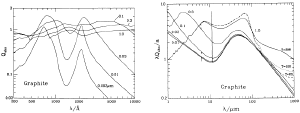 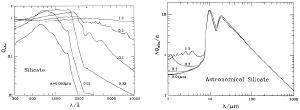
- (Ossenkopf & Henning, 1994A&A...291..943O)
Facts: Based on their dust grain accretion and coaggulation model, they compute and tabulate dust opacities from 1um to 1.3mm for grains in dense cores (with standard MRN-distribution of grain sizes). (for grains in diffuse clouds, see Draine & Lee, 1984ApJ...285...89D). The optical property of the ice mantle is that of the 'weak interstellar mixture' (H2O:CH3OH:CO:NH3=100:10:1:1).
Results: The tabulated dust opacities are reliable for dense core mass estimation with an uncertainty no larger than a factor of 2 (say, dust evolution and various parameters have little effects. They recommend 1.3-mm dust opacity of 1 cm2/g for very dense regions (nH>10^7 cm-3) and 0.8 cm2/g for intermediate densities (nH ~ 10^5 cm-3).
Data: The dust opcity data are available for MRN, MRN+thin ice and MRN+thick ice grains at VizieR: Online data.
The data are give for different ice layer thickness and gas density. They are continuous function of the parameters and interpolation can be applied. (hyperbolic interpretation in the logarithmic density and opacity regime, use their eq. 6).
- According to Mie's theory, the optical properties of dust grains are
strongly dependent upon size, shape and physical states (amorphous vs
crystallinity) of the dust grains.
- Optical constraints require that for effective emission at wavelength of
lambda by a grain of radius a, 2*PI*a should be <<
lambda. This implys
that most of the observed emitting dust grains in AGB stars are of a size
<< 0.1um. (Jura, 1990, 1990cgse.nasa...39J)
However, a portion of grains with larger grain sizes are needed to produce
observed polarization. (Martin and Rogers, 1987, ApJ, 322, 374; Groenewegen,
1997, A&A, 317, 503)
- (Draine & Li, 2007ApJ...657..810D)
IR emission spectrum of a mixture of Amorphous
silicates and graphite grains and
varying amount of PAH particles. Only
one-photon heating is considered. They present updated
IR absorption properties of PAHs. They give a grid
of IR emission models with various compositions that agree to Spitzer
observations of the Milky Way galaxy.
(figure: left -- Absorption
cross sections of neutral and ionized PAH; middle --
absorption cross section of ionized carbonaceous grains; right --
Emission spectra of Milky Way dust model with various amount of PAH and
heated by interstellar radiation field plus a stellar radiation field of
equal strength.)
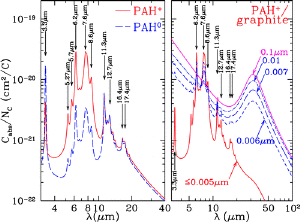 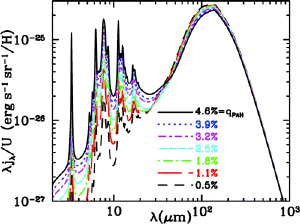
- (Pathak & Rastogi, 2008A&A...485..735P)
They modeled and compared PAH features...
- (Mutschke et al., arXiv:0810.3109)
New dust species with FIR features: talc -- 56.5um, 59.5um,
98.5um; montmorillonite --
several bands < 110um (including the 10um
wide 105um band); Picrolite -- a sharp 77um band; Charmosite
-- 72-92um band and 277um
band.
- (Speck et al., 2008ApJ...687L..91S)
They analysed the only oxygen-rich AGB star that show
crystalline silicate absorption features around 11.1um. The carriers
of both amorphous and crystalline silicates are dominated by forsterite (Mg 2SiO4) instead
of enstatite (MgSiO3) or other silicate compositions. The
11.1um feature usually mixes with the 9.8um amorphous silicate feature and
help broaden the latter.
(figs: left -- SED of
IRAS 17495-2534 showing fit of forsterite feature in the blow-up; right --
different crystalline dust formation temperatures in P-Td space.)
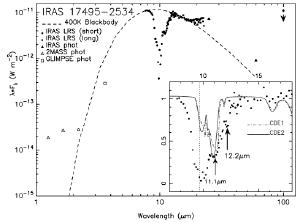 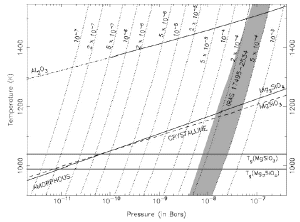
- (Zhang et al., arXiv:0903.4541)
They suggest that FeO is the most possible carrier of 21um feature that was seen in 16 C-rich PPNe.
|
![]()